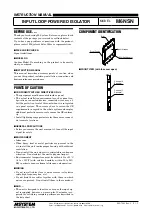
Engine Maintenance
65
The most common cause of fuel system problems
is contamination. It cannot be stressed enough that
the fuel must be clean, fuel tanks must be free
from contaminants, and the fuel filter must be
changed regularly. Any time that the fuel system
is opened up, all possible precautions must be
taken to keep dirt from entering the system. This
means all fuel lines should be capped when open.
The work should be done in a relatively clean
area, if possible, and the work should be
completed in the shortest time possible.
Thermo King recommends that any major
injection pump or nozzle repairs be done by a
quality diesel injection service specialty shop. The
investment in equipment and facilities to service
these components is quite high. Therefore, this
equipment is not found in most repair shops.
The following procedures can be done under field
conditions:
•
Bleeding air from the fuel system.
•
Maintenance involving the fuel tank and filter
system.
•
Speed and governor adjustments.
•
Electric transfer pump replacement or repair
(10 psig [69 kPa] pump with diesel filter).
•
Injection line replacement.
•
Pump timing.
•
Nozzle spray pattern testing and adjustment.
•
Minor rebuilding of nozzles.
Bleeding the Fuel System
The fuel system will have to have the air bled out
if the engine runs out of fuel, if repairs are made
to the fuel system, or air gets into the system for
any other reason.
NOTE: MAKE SURE to keep the fuel tank vent
open. If the vent becomes clogged, a partial
vacuum develops in the tank, and this increases
the tendency for air to enter the system.
Proceed as follows:
1. Loosen the bleeder screw on the inlet fuel
fitting of the injection pump.
2. Energize the fuel pump by using the Interface
Board Test mode to energize the Fuel On
Relay (K9). See the
µ
P-T Microprocessor
Diagnosis Manual, for information about the
Interface Board Test mode. Tighten the
bleeder screw on the injection pump when
clear flow of fuel appears.
NOTE: At initial start-up, open the bleeder
screw at the injection pump and bleed fuel
until a clear flow is noted.
3. Loosen the injector lines on the injection
nozzles.
4. Crank the engine until fuel appears at the
nozzles. Tighten the injector lines, and start
the engine.
NOTE: Fuel will not appear at the nozzles by
merely running the electric pump. The
engine must be cranked.
Summary of Contents for 919180
Page 4: ...4...
Page 10: ...Table of Contents 10...
Page 32: ...Unit Description 32 Unit Photographs Figure 3 Front View Figure 4 Back View AJA584 AJA585...
Page 33: ...Unit Description 33 Figure 5 Left Side View Figure 6 Right Side View AJA586 AJA58...
Page 35: ...Unit Description 35 Figure 8 North American Power Receptacle Box AJA58...
Page 38: ...Unit Description 38...
Page 58: ...Electrical Maintenance 58...
Page 66: ...Engine Maintenance 66 Figure 37 Fuel and Oil System Components...
Page 84: ...Engine Maintenance 84...
Page 96: ...Refrigeration Maintenance 96...
Page 118: ...Hilliard Clutch Maintenance 118...
Page 136: ...Cycle Diagrams 136...
Page 140: ...Wiring and Schematic Diagrams Index 140...
Page 141: ...141 Truck S Model SR 30 Schematic Diagram Page 1 of 2...
Page 142: ...142 Truck S Model SR 30 Schematic Diagram Page 2 of 2...
Page 143: ...143 Truck S Model 30 Units with P T Wiring Diagram Page 1 of 2...
Page 144: ...144 Truck S Model 30 Units with P T Wiring Diagram Page 2 of 2...
Page 145: ...145 Truck S Model 50 Schematic Diagram Page 1 of 2...
Page 146: ...146 Truck S Model 50 Schematic Diagram Page 2 of 2...
Page 147: ...147 Truck S Model 50 Units with P T Wiring Diagram Page 1 of 2...
Page 148: ...148 Truck S Model 50 Units with P T Wiring Diagram Page 2 of 2...
















































